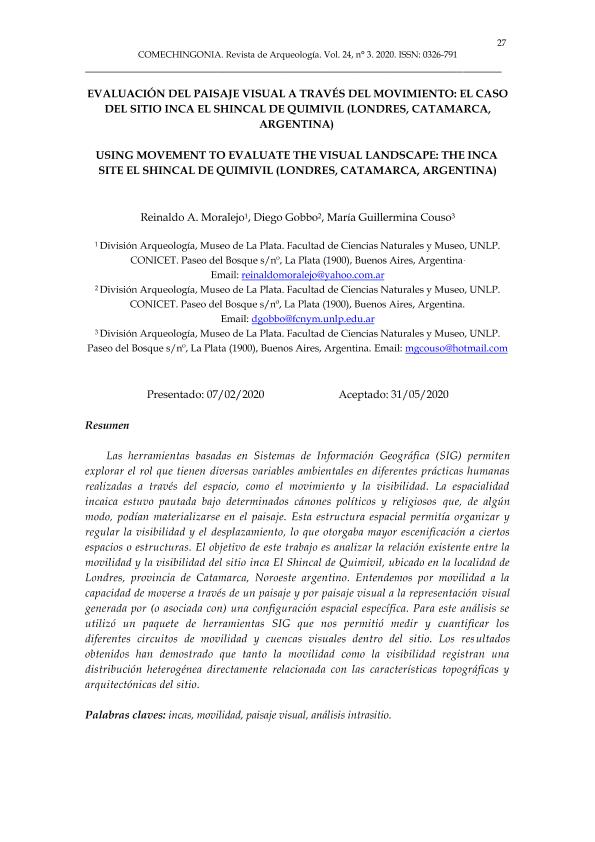Artículo
Las herramientas basadas en Sistemas de Información Geográfica (SIG) permiten explorar el rol que tienen diversas variables ambientales en diferentes prácticas humanas realizadas a través del espacio, como el movimiento y la visibilidad. La espacialidad incaica estuvo pautada bajo determinados cánones políticos y religiosos que, de algún modo, podían materializarse en el paisaje. Esta estructura espacial permitía organizar y regular la visibilidad y el desplazamiento, lo que otorgaba mayor escenificación a ciertos espacios o estructuras. El objetivo de este trabajo es analizar la relación existente entre la movilidad y la visibilidad del sitio inca El Shincal de Quimivil, ubicado en la localidad de Londres, provincia de Catamarca, Noroeste argentino. Entendemos por movilidad a la capacidad de moverse a través de un paisaje y por paisaje visual a la representación visual generada por (o asociada con) una configuración espacial específica. Para este análisis se utilizó un paquete de herramientas SIG que nos permitió medir y cuantificar los diferentes circuitos de movilidad y cuencas visuales dentro del sitio. Los resultados obtenidos han demostrado que tanto la movilidad como la visibilidad registran una distribución heterogénea directamente relacionada con las características topográficas y arquitectónicas del sitio. The tools based on Geographic Information Systems (GIS) allow us to explore the role that various environmental variables have in different human practices carried out through space, such as movement and visibility. The Inca spatiality was guided by certain political and religious rules that, in some way, could materialize in the landscape. This spatial structure made it possible to organize and regulate visibility and movement, which gave certain spaces or structures greater staging. The aim of this paper is to analyze the relationship between mobility and visibility in the Inca site El Shincal de Quimivil, located in Londres, province of Catamarca, Northwest Argentina. We understand mobility as the ability to move through a landscape and visual landscape as the visual representation generated by (or associated with) a specific spatial configuration. A GIS toolkit was used for this analysis, allowing us to measure and quantify the different mobility paths and visual basins within the site. The results obtained have shown that both mobility and visibility register a heterogeneous distribution directly related to the topographical and architectural characteristics of the site.
Evaluación del paisaje visual a través del movimiento: el caso del sitio inca El Shincal de Quimivil (Londres, Catamarca, Argentina)
Título:
Using movement to evaluate the visual landscape: the inca site el Shincal de Quimivil (Londres, Catamarca, Argentina)
Fecha de publicación:
11/2020
Editorial:
Centro de Estudios Históricos
Revista:
Comechingonia
ISSN:
0326-7911
e-ISSN:
2250-7728
Idioma:
Español
Tipo de recurso:
Artículo publicado
Clasificación temática:
Resumen
Archivos asociados
Licencia
Identificadores
Colecciones
Articulos(CCT - LA PLATA)
Articulos de CTRO.CIENTIFICO TECNOL.CONICET - LA PLATA
Articulos de CTRO.CIENTIFICO TECNOL.CONICET - LA PLATA
Citación
Moralejo, Reinaldo Andres; Gobbo, Juan Diego; Couso, Maria Guillermina; Evaluación del paisaje visual a través del movimiento: el caso del sitio inca El Shincal de Quimivil (Londres, Catamarca, Argentina); Centro de Estudios Históricos; Comechingonia; 24; 3; 11-2020; 27-54
Compartir
Altmétricas




